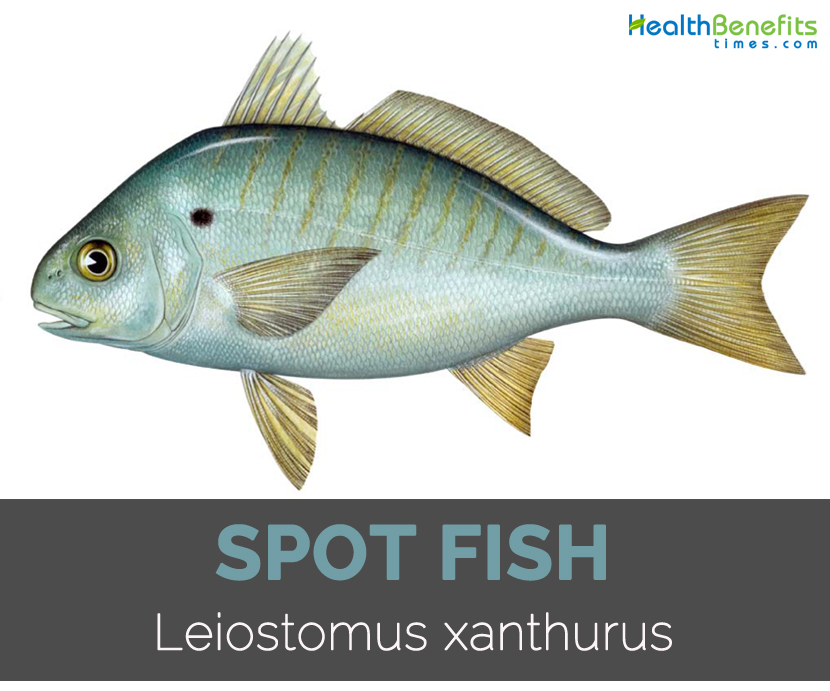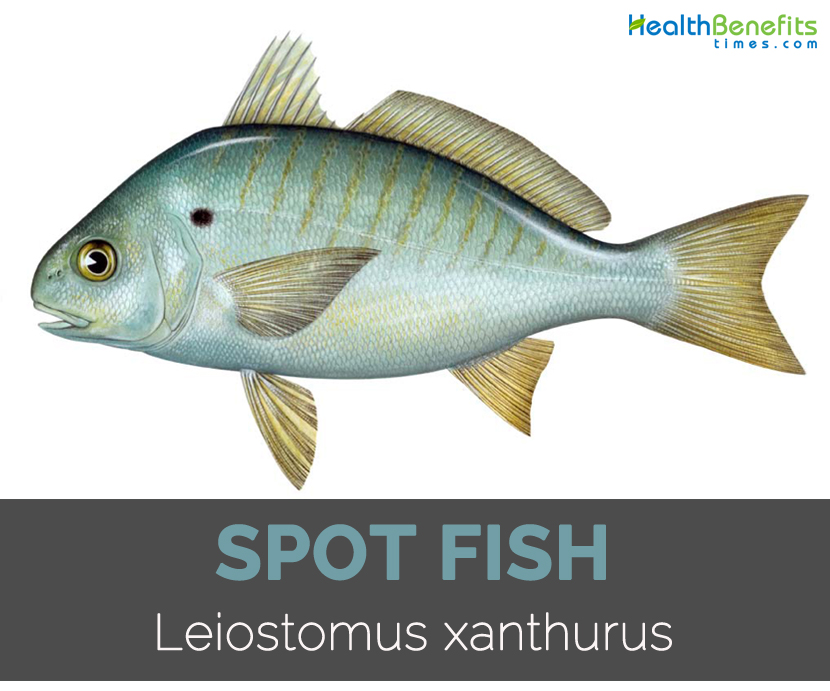| Spot Fish Quick Facts | |
|---|---|
| Name: | Spot Fish |
| Scientific Name: | Leiostomus xanthurus |
| Origin | Native to the west central and northwest regions on the Atlantic Ocean |
| Colors | Bluish-gray |
| Shapes | Deep-bodied, compressed |
| Taste | Medium-dense |
| Calories | 79 Kcal./cup |
| Major nutrients | Vitamin B-12 (80.00%) Selenium (42.55%) Isoleucine (32.66%) Lysine (32.54%) Tryptophan (30.00%) |
It is deep-bodied and compressed fish having an elevated back. Typically, body color is bluish-gray dorsally that fades to golden yellow or yellow-tan ventrally. The set of 12 to 15 dark streaks run obliquely from dorsal surface down the sides to mid-body. It fades with age. Typically fins are pale yellow in color. Head is short having small and inferior mouth. Maxilla extends to middle of eye. The continuous dorsal fin have notch isolated spinous portion from soft rays. There are 29-35 soft rays and 9-11 dorsal spines. Anal fin have 2 spines and 12 to 13 rays. There are 72 to 77 lateral line scales.
Appearance
Spot fish has bluish to gray body having brassy white belly and 12-15 dark and angled bars across back. It has large, distinctive black spot near its gill opening. It has deep notch and pale fins in its dorsal fin and forked tail fin. Its rounded and high back slopes down to small head. The lower jaw has no teeth. It could measure 11-12 inches in length.
Predators
Its predators include silversides that may affect postlarval distribution in estuaries. Adult spot and juvenile are the prey of many fishes such as seatrout, sharks, striped bass, mackerels and flounders.
Reproduction
Spot fish moves offshore to spawn in shallow to middle shelf waters. The spawning period extends from fall to early spring. The period is October to February in North Carolina and in Florida, from December to March. The spawning exist in water little deeper and further offshore. Eggs (one hundred thousand to 1.7 million) are carried shoreward by winds or currents. The external fertilization occurs at night in shallow waters. Larvae rapidly grow in warmer offshore waters. Young ones move into coastal shallows and lower bays during winter where they spend their first year. During summer, young resides in tidal creeks or shallow estuarine areas. They go to deeper estuarine waters or ocean during winter. They move to areas having lower salinity or freshwater till they are old enough to return back to saltwater. When spot becomes 186 to 214 millimeters in length (2 to 3 years), it reaches the age of maturity.
Habitat
They live in salt waters such as brackish water mostly over muddy and sandy floors. Until spring, it lives in estuaries and bays when it migrates to deeper water it spawns in. It moves to water having high salinity during summer and then moves offshore when autumn begins and water starts to cool.
Diet
Spot fish are omnivorous and consumes small crustaceans, benthic invertebrates, animal detritus and plant. It includes worms, polychaetes, small plankton, small fish and mollusks.
Distribution
Spot fish is inherent to west central and northwest region on Atlantic Ocean. It is found along Gulf of Mexico, along southern coast of U.S. from Massachusetts and down to Campeche, Mexico. Literally, it is found in depth of 6 meters but could also be found up to the depth of 50 meters. It is irregularly found in South Florida, near Cape Cod and the Florida Keys.
Precautions
It may lead to food poisoning causing symptoms such as stomach ache, head ache, dizziness, vomiting, diarrhea, general numbness a tingly sensation of arms, legs and around your mouth.
Other Facts
- Spot fish are abundantly found in the Chesapeake Bay.
- They are popular with recreational anglers.
- It vibrates swim bladder using special muscles to make croaking or loud drumming sound.
- In 1980, the recorded spot weighed 2.5 pounds in Chesapeake Bay.
References:
https://www.itis.gov/servlet/SingleRpt/SingleRpt?search_topic=TSN&search_value=169267#null
https://en.wikipedia.org/wiki/Spot_(fish)
https://www.chesapeakebay.net/S=0/fieldguide/critter/spot
http://www.virginiaseafood.org/consumers/factsheets/spot.htm
Comments
comments

